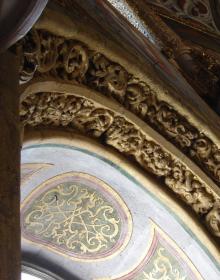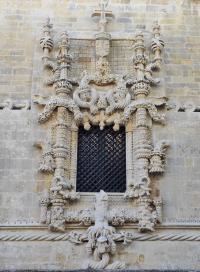- HOME
- MONUMENT
- Convent of Christ
- History
- Architecture
- Personalities
- King Afonso Henriques
- D. Gualdim Pais
- King Dinis
- King John I
- D. Lopo Dias de Sousa
- King Duarte
- Prince D. Henrique (Henry
- King John II (1455 - 1495
- King Manuel I (1469 - 152
- Diogo de Arruda
- João de Castilho
- Jorge Afonso
- Olivier de Gand
- King John III (1502 - 155
- Diogo de Torralva
- Friar Anthony of Lisbon
- Baltazar de Faria
- Filipe Terzi
- Philippine Dinasty
- King Philip II of Spain
- King John IV
- Domingos Serrão
- Queen Mary II
- Prince Fernando
- Costa Cabral
- Artisans and Artists
- Intangible Heritage
- Related Heritage
- Glossary
- VISIT OUR MONUMENT
- HERITAGE LEARNING
- TOMAR
- MONASTERIES ROUTE

Architecture and Art
Altar Front - front end and main side of an altar table.
Altarpiece - retable structure, retabular machine - painted or carved structure of devotional character placed in altar like sacred space to place objects and liturgical objects and tools; usually presents itself leaning against a wall; may represent an episode of the sacred world or hosting several representations related to such field.
Aparelho - term used in the identification of the placement of construction materials in an architectural structure - either stony or ceramic.
Aparelho pseudo-isódomo - set of clusters of different heights but where base stone of each cluster are at the same height even though they may vary in length.
Apse - semi-circular, square or polygonal shaped construction domed or covered in wood, at the top of a church. It is at the centre of the liturgical space and therefore where usually the high altar is placed.
Arcade - sequence of supporting covering arches; gallery or passageway formed by a succession of arches.
Arch - building element and of support, made of staves that cover a vault between two fixed points.
Archivolt - protruding frames of an arch. In plural designates a set of scaled arches that tops a portal.
Ashlars - hewn, squared stone.
Back rest - posterior vertical plan of sitting piece of furniture
Balcony Window (Janela de Sacada) - open vault until the ground level of two sides usually presenting an outside balcony
Balustrade - set of balusters - small vertical elements, made up of pedestal, counter-curved shaped shaft and chapiter - laid out sequentially in a regular and spaced shape, with a handrail.
Baldacchino - structure made of stone or other materials, covered and placed on top of columns. Used to enrich a space or image; wooden or fabric frame leaning on a wall, over an altar, tomb, throne, etc.
Band - horizontal frame, frieze or ribbon.
Banquette - Protruding piece of an altar to place candlesticks or other liturgical objects.
Bar - in reference to tiles, a type of tiled panel embellishment. Made up of two series of juxtaposed tiles, limiting a composition
Baroque - Artistic style of historic category. Broadly it corresponds to the chronological period between 1580-1750, with its origin in Italy - In Portugal it refers to the period right before the Restoration and King José I´s reign; characterized by classical aesthetic language in which the artistic object is worked according to a persuasive intention - with elements of surprise - to movement, to illusion, to scenic effects, and at the same time to monumentality; curved, agitated, dynamic are expressive characteristics as well as the synthesis between architecture and the remaining arts - the decorative aspects are an integral part of the set.
Base - lower part of a column where the shaft sits.
Bevel (carving) - oblique design of an edge. In lower and medium reliefs it enhances the sharpness of the decorative motifs.
Blind Arcade - sequence of hollow and closed arches on a wall used in order to articulate the walled surface.
Body - middle space of an altarpiece structure; church - space between the chevet and the main entrance
Border - refers to tiles, a simple frame made of a series of juxtaposed tiles with the decorative motif limited by two borders.
Bulb-shaped - in the shape of a bulb
Buttress - constructive element adjoined to the exterior side of a wall, destined to reinforce the walled surface and/or support the weight of the arches and domes
Cachorro -sculpted or smooth stone where the moulding is set.
Cadeiral - row of seats, displayed in one or more rows in the lateral walls of the High Chapel, of the main nave of the High Choir of a church.
Caixotão - dented panel placed in the interior lower surface of roofing, limited by framing - usually of regular square or rectangular form even though there are a few polygonal examples - which can be painted or carved.
Cap - Element topping or crowning an architectural structure, retable or piece of furniture.
Capital - top piece of a column, pillar or pilaster formed by abacus.
Carpet - in respect of tiles, it refers to repeating patterns, applied over large areas, usually defined by frames; term applied also to other types of parietal finishes like mural painting.
Carranca - head or mask relating to fantastical imaginary, sculpted in rock, wood or metal, placed as a decorative motif on cymatium, frieze, attics, fountains, lavatories, etc.
Cenotaph - funereal and celebratory monument destined to hold someone´s ashes.
Chartula - ornamental form in the shape of a frame with an inscription, symbol, heraldic element or emblem which can be painted or sculpted
Chevet - area situated at the extremity of the temple, generally opposite the entrance area. It is edified from the top of the nave or the transept; corresponds to the space of the High Chapel or ambulatory or radiant chapels - if they exist.
Collateral Altar - Altar placed in the nave, positioned next to the adjoining walls of the triumphal arch; may have the same positioning as the wall that supports it or put in an oblique fashion.
Colonnade - sequence of columns that support an entablature or series of arches.
Column - usually cylindrical shaped support. Made up of three parts: base, shaft and capital
Composite Order - architectural order very similar to the classical Corinthian Order - the main difference occurs in the composition of the column´s chapiter with Corinthian decoration enhanced with volumetric volutes and ovule frieze.
Corbel - protruding architectural or decorative element, in the shape of a console, protruding from a vertical surface in order to support a sculpture, an arch, etc.
Cornice (Imposta) - protruding stone element - usually decorated - which separates the arch, dome or chapiter.
Cove - frame or linear element, decorated or plain, with some salience and horizontal development establishing the connection between the planes of walls and ceiling.
Dome -concave or arched roofing system, usually built in fitted rock or brick.
Embellishment - decorative limit of a composition; in reference to tiles, a delimitation of the panels by simple, double or composite rows of tile units.
Emblem - image made up of various elements with a concrete symbolic meaning; can be accompanied, or not, by a caption.
Engraved Stone - stone with inscription destined to honour and/or celebrate someone or to celebrate a fact.
Eucharistic Throne - wooden structure, located inside the tribune of the main altarpiece, organized in successive steps that gradually diminish in size, for the exposition of the Blessed Sacrament.
Ex-voto - pictoric or sculpted representation that is placed in a temple, in order to accomplish a vow.
Fin - curved element, sometimes in a volute shape, adjoined to right angles in architectural abutment or an altarpiece of piece of furniture.
Footing - each of a nave dividing parts on considering the ceiling support elements.
Foundation (Embasamento) - base which supports a building, an architectural element, altarpiece, piece of furniture.
Frieze - refers to the part of the entablature, between the architrave and the moulding; horizontal decorative strip which can have its interior painted or sculpted.
Gable - finish or crowning of an architectural or decorative structure, door, window or recess; can have different shapes; it has its root in classical architecture.
Gable Wall - high area or top of a façade where the roof beams are set.
Glyph - round-shaped linear groove, in half cane, open vertically in the shaft of a column, pillar or pilaster.
Gold engraving (Douramento) - applying gold-leaf over a previously prepared sculpted surface
Guard - baluster grid, wood, ply or stone panel used to prevent falls from stairs, counters and windows.
High Altar - Main altar of a church or chapel. Usually placed in the High Chapel and situated in its central shaft axial.
High Choir - area in the temple reserved to the clergy. Fundamental in the celebration of the Divine Office during the Modern Era; usually it is situated on a higher level over the main entrance of a church.
Iconography - discipline dedicated to the systematic study of imagetic representations that portray a specific artistic theme.
Ionic Order - one of three classic Greek architectural orders; it is mainly characterized by the column with a grooved shaft placed attic base and rectangular helix abacus adjoined to iron supports.
«Joanino Style» (referring to King D. João V) - designation attributed to carving produced with a clear Italian influence, enhancing the scenic effect by the efficient organization of structural and decorative elements in the altarpiece; the origin of this term occurs due to the similar date of a set of altarpieces that had identical formal characteristics - during King João V´s reign. These present a specific decorative language including the berniniana column (refers to Italian sculptor Bernini), the introduction of curtains, pelmet, baldaquins, the use of festoons, garlands, winged harlequins, human figures supporting cornices (atlante), shells among other elements.
Lado da Epístola - expression used to designate the right side (nave) of a temple when looked upon from the entrance.
Lado do Evangelho - expression used to designate the left side (nave) of a temple when looked upon from the entrance.
Lambrim - ceramic coating, of wood, stone or stucco applied on interior walls at a certain height.
Lateral Altar - secondary altar placed in the walls that constitute the nave´s elevated laterals of a church or chapel.
Lavabo / Washing basin - fountain placed in the sacristy so the priest can wash his hands before and after celebrating Mass; fountain placed at an angle in the cloister next to the entrance to the mess so that before and after meals the community can wash their hands.
Mannerism, mannerist - term that designates a tendency or artistic style of Italian origin. In Portugal it broadly corresponds to the second half of the 16th century and the first half of the following century; with its roots in renaissance it is seen as a transgression to the classical ideals for art, transposing the elements resulting in ambiguous works, disregarding the classical strictness and exploring unexpected effects.
Maquineta - small oratorium-closet, portable with one or more glazed sides holding a statue.
Midriff-Arch - arch built in cross-cutting fashion in order to support the weight that the ceiling exerts on the lateral façades.
Modillion - same as cachorro
Modinatura - set of different frames of a constructive element.
Moulding - protruding frame that finishes the top side of a wall.
«National Style» - expression initially suggested by Germain Bazin and Robert Smith to classify gold-leafed altarpieces that had similar formal characteristics: the use of paired twisted columns (Torsa), extended in concentric archivolts which envelop the tribune and the Eucharistic throne. According to the authors, reminds the organization of the Romanesque doorways; the decoration mainly consists of extensive application of acanthus leaves, vine leaves, young boys and birds looking through a bunch of grapes, and also cherubs in an iconographic logic that refers to the liturgical practice of the Mass.
Nave - longitudinal space or area of a church or chapel, situated between the main entrance and chevet, delimited by support architectural elements such as walls, columns, pillars, arches, etc.
Neoclassicism, neoclassical - artistic movement developed from the last decade of the 18th century, characterized by the inspiration in the rigueur of the Greek-Roman classical shapes, especially in its usage of the decorative grammatical characteristics; applied to architecture and other arts, it results in simple and elementary works, of bridled decoration and assuming a grand monumentality in architecture.
Orago - evocation of a saint to whom a church or chapel is dedicated to.
Pattern (padronagem) - term relating to patterns applied in decoration; pattern - decorative composition defined by the repetition of a module
Phytomorphic - ornamentation or decorative motif in the shape of a vegetable.
Pilaster - vertical support element or of decorative function. Square or polygonal shaped, adjoined to a wall.
Pillar - vertical element of tectonic function. Rectangular, cross or polygonal shaped.
Plinth - square-shaped element where the base of a column or a pedestal is placed.
Porch (galilé)- protruding body in relation to the main façade or to the lateral façades of a building which serves as a gallery; usually supported in architectural supporting elements such as columns or pillars but it can also be a closed space into which one enters through a doorway.
Quadrilobe - Decorative element formed by four curved, arched or connected segments.
Quoin - decorative element of classical origin that uses a palm leaf.
Register - area where elements or figures at different levels within the same composition are positioned, being said that are in different registers.
Rococo, rocaille - Term to designate the late phase of Baroque, being a reaction to its classicizing forms; primarily it affects the decorative language that usually enriches interiors, transforming them through its great composing freedom into extremely refined spaces by using a formal language based on exotic and, in a sense, bizarre motifs; curved or "bat wing" motifs asymmetrically placed, combined with vegetal like elements are rather typically preferential; in architecture it explores in a sublime way the values of light, the role of artistic overlays and chromatic games.
Rose Window - niche for circular lighting, usually in a stone grid.
Serliana - Palladian sequence of three bays, the central being in a perfect vaulted arch and higher than the side ones, these being of straight lintel.
Shaft - vertical piece of a column, generally circular or polygonal between the base and the chapiter.
Sigla -stone mason marks on the ashlars or other building parts, to signal authorship, when the work was paid to task; positioning mark that was intended for right placement of parts at construction.
Soffit - the interior curve or surface of an arch or dome.
Square of the Transept -space that results from the crossing of the main nave and the transept
Stave - referring to quoin rock or brick shape displayed radially in arches or domes.
Stencilling (Estampilhagem) - decorative technique to print a design unto a surface through stencilling (estampilha - sheet of paper or parchment where a design is cut and repeated many times over).
Talha - type of wood coating carved by chisel and gouge that may or may not receive subsequent finishing by gilding or painting.
Thurible - varied shape liturgical metal object suspended from linked chains for burning incense during sacred ceremonies
Tile - ceramic plaque with variable thickness, usually square-shaped, decorated and glazed on one side. Its main function is to cover decoratively a wall or roofing.
Torus - round section relief frame
Trace - building design, drawing or project, retable, etc.
Transept - cross body of one or more naves, built at right angles to the nave (or naves) of a temple.
Tribune - an altarpiece structure as an elevated balcony, it corresponds to the hollow area hosting the Eucharistic throne.
Triumphal Arch - spanned arch, usually of great proportions, that connects between the nave and the High Chapel or between the nave and the temple´s transept.
Tromp l'oeil - illusion creating pictorial technique.
Tuscany Order - architectural order of roman origin deriving from the classical Greek Doric order; the columns have a smooth shaft and base with double torus on a plinth.
Twisted Column (Torsa) - column with a spiral shaft
Tympanum - the element that closes the semicircular part of a niche originated by an arch construction. The portals usually house a sculpture.
Ventana - window or arch of the bell tower or campanile, which houses the bell.
Volute - Decorative element imitating rolled leather that describes, in section, a spiralling movement.
SERVICES - ACTIVITIES



